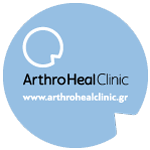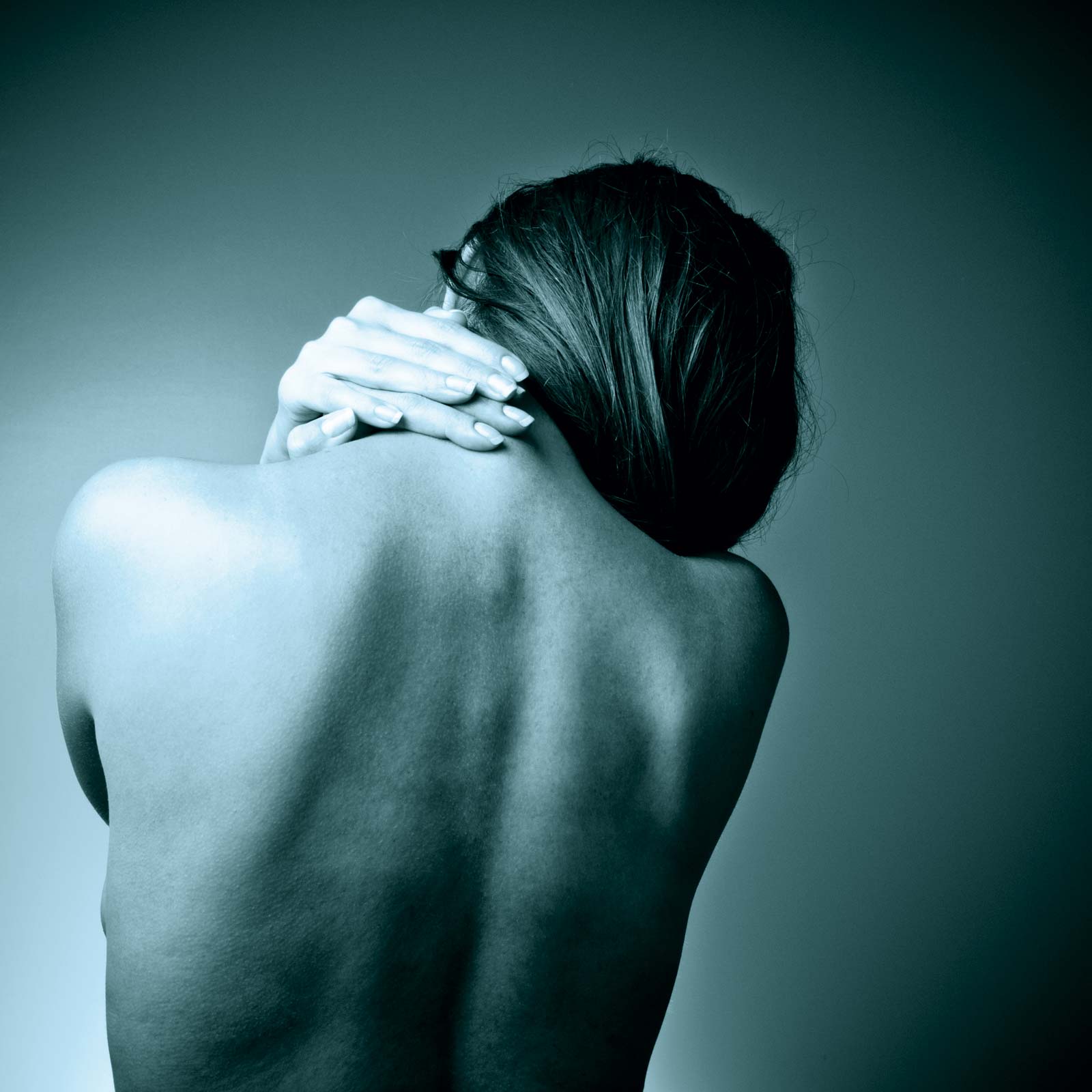OSTEOPOROSIS
GENERALL
The skeleton provides a stable substrate for the adhesion of the muscles, protects the vital organs and hosts within the bone marrow.
Contains 99% of total body calcium and plays a major role in the maintenance of calcium in the body after a period of insufficient intake from diet or poor absorption from the small intestine bones provide the desired level of calcium in the blood in the process of osteolysis.
Macroscopically bones are composed of two types 1. cortical bone and cancellous bone 2.. Cortical bone covers about 80% of the total skeleton and an outer sheath of the long bones in these diaphysis.
The spongy bone found at the ends of long bones (metaphysis, pineal gland) as well as in the lumen and the vertebrae.
Bones are composed of three types of cell 1. osteoclasts, osteoblasts and 2. osteocytes. Osteoclasts are the cells that absorb the bone tissue, osteoblasts form new bone (initially creating the foundation to which is gradually added minerals) and osteocytes which are substantially finally differentiated osteoblasts and constitute 90% of the cells of the mature skeleton.
The balance between cell function ensures their healthy compact bone structure.
Osteoporosis is defined as a disturbance of the quantity and quality of bone disorder microarchitecture of resulting in embrittlement and fracture generation probability.
The disease affects cortical and the cancellous bone and has been described as "silent disease" because it progresses gradually without obvious symptoms. But there remains a serious health problem affecting around the frame, not just the spine.
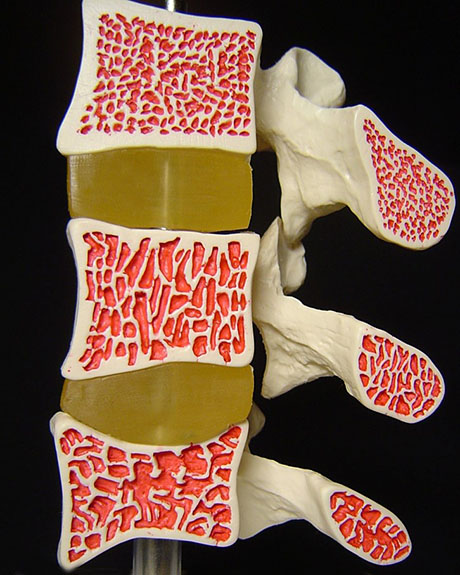
Upper vertebra: Normal dense
Midlle vertebra: Osteopenia
Lower vertebra: Osteoporosis. The bone trabecices have been diluted a lot and some have been broken (bone fracture). There is also a decrease in the height of the vertebra and its deformation
In the picture the 1st (up) vertebra is normal. The density of the structure is very compact.
The middle vertebra has osteopenia, has begun to lose its density and durability.
The lower vertebra is osteoporotic. Bone structure is much lighter than normal thereby lose its normal height causing severe pain in the patient's back.
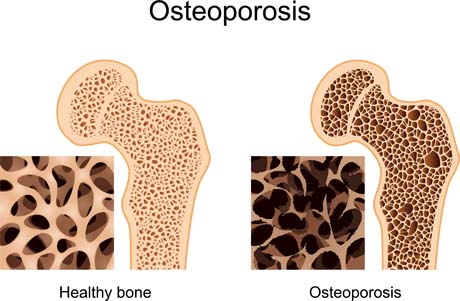
HOW MANIFESTED?
Usually the first obvious symptom is a bone fracture (hip, wrist, vertebra). Other prominent symptoms may be the loss of height and kyphosis (arching), occurring gradually over time.
Sometimes a back pain in a woman who has entered menopause may be the first symptom of an approaching osteoporosis. Finally, the disease can cause changes that go unnoticed, but which can be identified with the appropriate diagnostic tests.
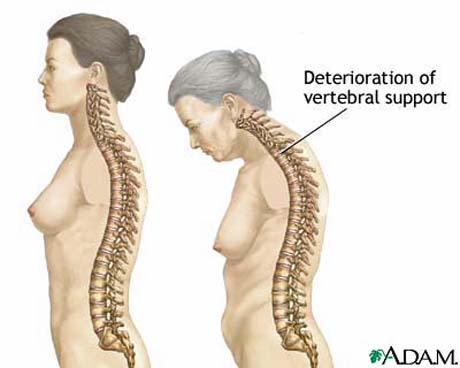
Gradual loss of height as the end of age due to osteoporosis.
X-ray: cuneiform deformation of multiple thoracic vertebrae
The thoracic vertebra fractured due to osteoporosis
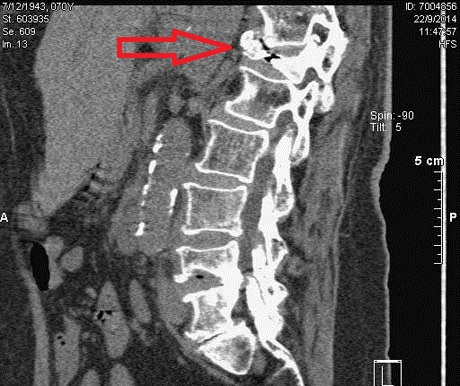
WHAT RISK?
People at risk of suffering from osteoporosis are:
• The genetic factor may play an important role in determining the peak bone density and influence bone loss related to age.
Family history (hip fracture) is an important risk factor and confirms the influence of heredity on osteoporosis event.
• Postmenopausal women, particularly in those in which the menopause occurred before the age of 45 years.
• Men and women who have hormonal disorders (thyroid. Parathyroid, sex hormone disorders)
• Individuals who make systematic long-term use of certain categories of pharmaceuticals such as steroids, antidepressants, thyroid hormones, anticonvulsants etc.
• People whose diets are low in calcium (low consumption of milk, dairy products)
• People who are not exposed to the sun
• People who are sedentary
• Chronic smokers and those who consume large quantities of alcoholic beverages
• Patients who have chronic problems, such as diabetes, cystic fibrosis, malabsorption syndromes food, kidney disease, bulimia, anorexia and endocrine disorders
• People who have a low body weight and small stature regardless of age.
Osteoporosis has been associated mainly with postmenopausal women, and both men of all age groups and in young women.
PREVENTION
Prevention is always better than cure. The bone grows mainly during adolescence and finally arrive at their maximum density at the age of 27-30 years.
Throughout the course of this development period of the human skeleton we all have the ability and opportunity to make our bones strong by eating foods from all the food groups and following a systematic fitness program.
1. NUTRITION
Throughout our lives we must take adequate amounts of calcium. Since scientific research has shown that lack of calcium is one of the main causes of osteoporosis.
- CALCIUM
The recommended daily amount for adults is 800-1000 mg daily, for menopausal women 1500 mg per day for the elderly 1200 mg a day.
Rich sources of calcium are milk, dairy products (feta cheese, yellow cheese, etc.), egg, green leafy vegetables, broccoli, legumes, cereals and nuts. Equally beneficial effect on health have calcium supplements allocated to various conditions such as lactose intolerance.
It should be noted that increased calcium intake is not able to protect you, as the lack of other elements from the body ultimately contributes to the onset of osteoporosis.
The levels of calcium products are:
Milk 1 cup (250 ml) = 300 mg Calcium
Milk 1 cup (250 ml) calcium enriched = 430 mg calcium
1 yogurt (200ml) calcium enriched = 280 mg calcium
- VITAMIN D
Vitamin D plays a crucial role in the absorption of calcium as an essential means of transport of the medium. Calcium intake without simultaneous intake of vitamin D does not provide any benefit for the prevention and treatment of osteoporosis.
The main source of vitamin D in the Mediterranean countries is the sun. The individual's exposure to the sun provides through the skin, liver and kidneys (metabolic pathway of vitamin), all the necessary amount needed by the body.
Inadequate exposure to sunlight and poor diet butter, fatty fish, eggs and milk can contribute to the onset of osteoporosis.
2. GYMNASTICS
Physical exercise on a daily basis can help strengthen bones, enough being systematic and always under the guidance of a specialist (physiotherapist, trainer).
Walking, running, cycling, a muscle stretching program as well as program with light weights (or resistors with special tires) and aerobics can be particularly beneficial for all age groups.
At older ages, the choice of aerobic fitness program in water is a safe and effective solution. Of course it is preferable sport start from the childhood.
Before an adult decides to start any form of exercise it is advisable to contact the cardiologist and make a full cardiac monitoring (ECG, cardiac ultrasound, stress test).
The right equipment (especially shoes, athletic wear) significantly reduce the percentage of injury to persons
3. PREVENTIVE LABORATORY TESTS
• IMAGING TESTS
The first step in the diagnosis of osteoporosis is the measurement of bone density by DEXA method, since this is the best marker for the prevention of future fractures.
The first measurement should be done at the beginning of menopause, or earlier if the woman had surgery genital organ. This measurement will essentially become the benchmark for future examinations.
On whether it is often necessary to repeat the test measurement of bone mass will determine your Orthopaedics.
• BLOOD TEST
These tests include blood testing, biochemical and hormonal profile. Through this test we see bone metabolism (Bone turnover), while control of thyroid and parathyroid hormone is necessary because the dysfunction of the endocrine glands of these can be a silent but treatable cause of osteoporosis.
It is wrong to treat osteoporosis as a symptom and not to investigate the cause. Can the treatment of cause to effect and the definitive treatment of the disease.

